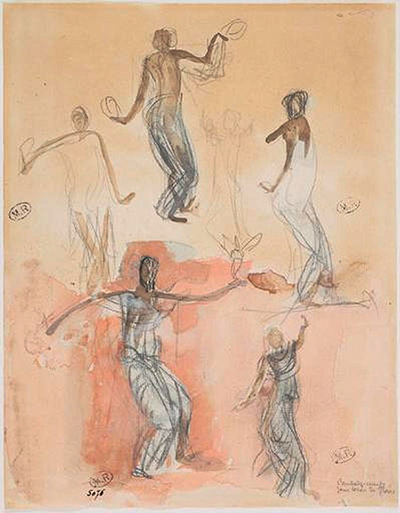Auguste produced these study drawings to illustrate his fascination with the Cambodian dancers during the 1906 Colonial show of Marseilles. The dancer's performance had captured the mind of the French public. However, it was Rodin’s art that helped immortalise this prehistoric Khmer dance.
Rodin's fascination with the aesthetics of these dancers caused him to sketch 150 drawings, interpreting their poses within a week. When the pictures were displayed, it was evident that Auguste’s enthusiasm was on the impact that the dancers had on him, not their skill as performers. Rodin then decided to follow them to Marseille where they would embark on their journey to Cambodia.
Auguste created this drawing in the late phase of his career when he was fascinated by the possibilities of musculature, shape, tension and expressiveness contained within the body of the subject. He was more inclined to showcase the dynamics of flight and motion. It explains why the sculpture displays dancers who are always moving in great detail with faces composed of dotted eyes and a scrawled mouth. It was a great contrast from George Bois drawings that were dubbed The tale of the Cambodian Dancers. Bois was a great admirer of Rodin's work and had published sketches of the dancers using bright and varying colours to capture the energy of their costumes. The position of the dancers was rather rigid as George was inclined to showcase the heavy golden garments that almost dwarfed the young girls.
Rodin's detailed execution was indicative of Europe's association with foreign ways of life at the time. He pulled the performers out of context, stripping them off the storyline, costume and individual identity and prioritised motion and form exhibited during the dance. The most striking image is that of the acrobat Alda Moreno, who Auguste sculpted in her signature pose, balancing on one leg while the other touched the crown of her tilted head. It illustrates Rodin's fascination with the power of posture, the thrilling play of angles that allowed him to render Moreno’s secret parts- the belly, breasts and private parts.
Related Sculpture - The Walking Man
After creating the Age of Bronze sculpture, Rodin's style had shifted to depict motion rather than fixated subjects that were reminiscent of the traditional academic pose. His 1907 carving, dubbed The Walking Man portray this style vividly as Rodin carves a fragmentary figure without the head or arms fixed on two legs. He intentionally ignores all anecdotal details to focus on movement.




